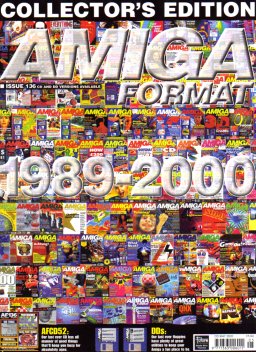- Amiga Format
Infobox_Magazine
title = Amiga Format
 | image_size = 200px | "The cover of the final issue of Amiga Format (May
| image_size = 200px | "The cover of the final issue of Amiga Format (May 2000 )"
editor = Bob WadeDamien Noonan Marcus Dyson Steve Jarratt Nick Veitch Ben Vost
frequency = Monthly
circulation = 161,256 Jan - Jun 1992
category = ,
company =Future Publishing
firstdate = July 1989
finaldate = May 2000
finalnumber = 136
country =United Kingdom
language = English
website =
issn = 0957-4867"Amiga Format" was a British
computer magazine forAmiga computers, published byFuture Publishing . The magazine lasted 136 issues from 1989 to 2000. The magazine was formed when, in the wake of selling "ACE" toEMAP , Future split the dual-format title "ST/Amiga Format " into two separate publications (the other being "ST Format "). At the height of its success the magazines sold over 170,000 copies per month, topping 200,000 with its most successful ever issue.History
"Amiga Format" can be thought of the "mother" or "big sister" magazine of the more infamous magazine "
Amiga Power ", which it both predated and outlived. Whereas "Amiga Power" was strictly games-only, "Amiga Format" covered all aspects of Amiga computers, both hardware and software, bothproductivity and gaming uses. A further spin-off was "Amiga Shopper ", which dealt purely with the hardware and "serious" software side of the Amiga scene.The magazine offered various multi-issue tutorials on different productivity software, such as C programming or
LightWave graphics rendering. The last tutorial was cut short in the middle because of the cancellation of the magazine."Amiga Format" pioneered the concept of putting complete productivity software on a magazine coverdisk as a response to a moratorium on complete games titles being cover-mounted.
"Amiga Format" was the second-to-last regularly issued print magazine about the Amiga in the United Kingdom. The last was "
Amiga Active ", which ran for 26 issues from October 1999, although "Amiga Format" was the only such magazine afterCU Amiga Magazine 's closure in October 1998 until the launch of "Amiga Active".Regular features
Reader Games
A notable regular feature in the later stage of the magazine (introduced by then-editor
Nick Veitch ) was "Readers' Games". Here readers of the magazine could send in games they had programmed themselves, and the magazine staff would then publish a brief review of them. In theCD-ROM edition of the magazine, all the Readers' Games were also included on thecovermount CD-ROM. Most of the games were written inAMOS BASIC orBlitz BASIC .In one issue a competition was run to find the best game developed by a reader using a previously covermounted version of Blitz BASIC. A game called "Total Wormage" was entered by Andy Davidson but did not win – this game was later further developed and published by
Team17 as the successful game, "Worms". Although this story has become popular part of the Worms mythology, nobody who was judging the games actually remembers seeing Worms at all...Emulators
While the continuing uncertainty about the Amiga platform's future slowed software development, there was an increase in the interest surrounding emulation software. long time contributor Simon Goodwin contributed one of the longest running series to the magazine, which broke down emulators by target platform and went through the mechanics of getting them working
Just the FAQs
Introduced in issue 129 and continuing until the final issue, "Just the FAQs" consisted of a single page each month containing an interview with a prominent figure in the Amiga community, with the exception of the January 2000 issue (published in December 1999), which instead explained the limited effects the
Year 2000 problem would have on the Amiga. [Olaf Barthel, "Just the FAQs", "Amiga Format", January 2000 (issue 132), 86]Interviews were conducted with Chris Wiles (
managing director of Active Technologies), Neil Bothwick (founder of the Wirenet ISP), Alan Redhouse (of Eyetech), Wolf Dietrich (head of phase 5), Andrew Elia (of AmigaSoc), and Ben Hermans (of Hyperion Software). [Chris Wiles, "Just the FAQs", "Amiga Format", November 1999 (issue 129), 92] [Neil Bothwick, "Just the FAQs", "Amiga Format", December 1999 (issue 130), 92] [Alan Redhouse, "Just the FAQs", "Amiga Format", Christmas 1999 (issue 131), 86] [Wolf Dietrich, "Just the FAQs", "Amiga Format", February 2000 (issue 133), 86] [Andrew Elia, "Just the FAQs", "Amiga Format", March 2000 (issue 134), 78] [Ben Hermans, "Just the FAQs", "Amiga Format", April 2000 (issue 135), 78] In the final issue, a special interview was conducted with Eric Schwartz'scartoon character Sabrina. [Eric Schwartz, "Just the FAQs", "Amiga Format", May 2000 (issue 136), 78]Backstage
"Backstage" was a four page
newsletter sent tosubscriber s with each issue. The tone of the newsletter was less formal than that of the magazine, and it would often provide behind-the-scenes information on the activities of prominent members of the "Amiga Format" staff. "Backstage" also gave details of the contents of the Subscribers' Superdisk (an extrafloppy disk sent to subscribers, whose contents were also stored in a password-protected archive on the cover CD), and featuredspecial offer s for subscribers.References
External links
* [http://www.amigahistory.co.uk/aformat.html Amiga History Guide: Amiga Format]
* [http://www.davidviner.com/mags.php David Viner - UK Computer Magazines]*Archived articles originally published in Amiga Format:
** [http://simon.mooli.org.uk/AF/article/GOODWIN/GOODWIN.HTML Amiga audio, networking and system stability]
** [http://simon.mooli.org.uk/AF A long-running series of articles about emulators] (for other computers running on Amigas)
** [http://www.wirenet.co.uk/tutorials/UsingHTML/ "Using HTML"] - Neil Bothwick's HTML tutorial
** [http://www.wirenet.co.uk/tutorials/PracticalJavaScript/ "Practical Javascript"] - Neil Bothwick's Javascript tutorial
Wikimedia Foundation. 2010.
